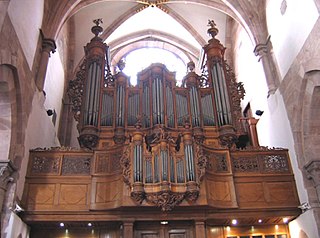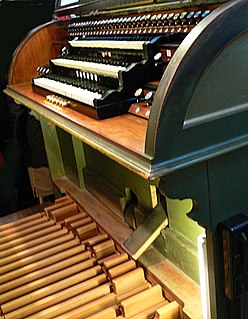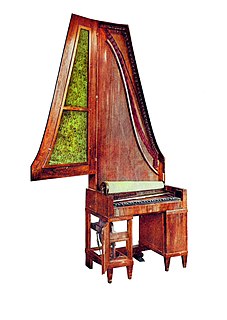
The physharmonica is a keyboard instrument fitted with free reeds, a kind of harmonium much used in Germany in the early 20th century. [1]

The physharmonica is a keyboard instrument fitted with free reeds, a kind of harmonium much used in Germany in the early 20th century. [1]
The physharmonica resembles a small harmonium, but is differentiated from it by having no stops, being without percussion action, having only a 4 octave compass, and not speaking readily or clearly. As with the harmonium, the bellows are worked by the feet by an alternate movement, which also affords a means of varying the dynamic force of the tone according as more or less energetic pedalling increases or decreases the pressure of the wind supply. [1]
The physharmonica was invented in 1818 by Anton Haeckl, of Vienna; in the original instrument the bellows were placed right and left immediately under the shallow wind-chest, and were worked by means of pedals connected by stout wire. A specimen, having a compass of four octaves and a very sweet tone, is preserved in the collection of Paul de Wit, formerly in Leipzig, transferred to Cologne and then back to Leipzig's Grassi Museum. [1]
A patent for improvements to this type of instrument was granted to Anton Reinlein 1824. Christian Friedrich Ludwig Buschmann also built similar instruments at least by 1828. There were also others who produced these instruments such as Johann Caspar Schlimbach with Bernhard Eschenbach, Carl Friedrich Voit in Schweinfurt and Friedrich Sturm) in Stuhl.[ citation needed ]

Accordions are a family of box-shaped musical instruments of the bellows-driven free-reed aerophone type, colloquially referred to as a squeezebox. A person who plays the accordion is called an accordionist. The concertina and bandoneón are related. The harmonium and American reed organ are in the same family, but are typically larger than an accordion and sit on a surface or the floor.

The pipe organ is a musical instrument that produces sound by driving pressurized air through the organ pipes selected from a keyboard. Because each pipe produces a single pitch, the pipes are provided in sets called ranks, each of which has a common timbre and volume throughout the keyboard compass. Most organs have many ranks of pipes of differing timbre, pitch, and volume that the player can employ singly or in combination through the use of controls called stops.

In music, the organ is a keyboard instrument of one or more pipe divisions or other means for producing tones, each played with its own keyboard, played either with the hands on a keyboard or with the feet using pedals.

The contrabass clarinet and contra-alto clarinet are the two largest members of the clarinet family that are in common usage. Modern contrabass clarinets are pitched in B♭, sounding two octaves lower than the common B♭ soprano clarinet and one octave lower than the B♭ bass clarinet. Some contrabass clarinet models have a range extending down to low (written) E♭, while others can play down to low D or further to low C. This range, C(3) – E(6), sounds B♭(0) – D(4). Some early instruments were pitched in C; Arnold Schoenberg's Fünf Orchesterstücke specifies a contrabass clarinet in A, but there is no evidence of such an instrument ever having existed.

In music, the range, or chromatic range, of a musical instrument is the distance from the lowest to the highest pitch it can play. For a singing voice, the equivalent is vocal range. The range of a musical part is the distance between its lowest and highest note.

The pump organ is a type of free-reed organ that generates sound as air flows past a vibrating piece of thin metal in a frame. The piece of metal is called a reed. Specific types of pump organ include the reed organ, harmonium, and melodeon. The idea for the free reed was imported from China through Russia after 1750, and the first Western free-reed instrument was made in 1780 in Denmark.

An expression pedal is an important control found on many musical instruments including organs, electronic keyboards and pedal steel guitar. The musician uses the pedal to control different aspects of the sound, commonly volume. Separate expression pedals can often be added to a guitar amplifier or effects unit and used to control many different aspects of the tone.

A harmonichord is a kind of upright piano in which the strings are set in vibration not by the blow of the hammer but by indirectly transmitted friction.

A portative organ, also known during Italian Trecento as the organetto, is a small pipe organ that consists of one rank of flue pipes, sometimes arranged in two rows, to be played while strapped to the performer at a right angle. The performer manipulates the bellows with one hand and fingers the keys with the other. The portative organ lacks a reservoir to retain a supply of wind, thus it will only produce sound while the bellows are being operated. The instrument was commonly used in European secular music from the twelfth to the sixteenth centuries.

The regal is a small portable organ, furnished with beating reeds and having two bellows. The instrument enjoyed its greatest popularity during the Renaissance. The name was also sometimes given to the reed stops of a pipe organ, and more especially the vox humana stop.
Pommer or bombard describes the alto, tenor, bass, and contrabass members of the shawm or Schalmey family, which are similar in function to the modern cor anglais, tenoroon, bassoon, and contrabassoon, although the bassoon family's direct ancestor was the dulcian/curtal family.

Sordun is a family of archaic wind instruments blown by means of a double reed
The barbiton, or barbitos, is an ancient stringed instrument known from Greek and Roman classics related to the lyre. The barbat or barbud, also sometimes called barbiton, is an unrelated lute-like instrument derived from Persia.

The organ in St. Jacobi Church, Hamburg, was built in 1689 – 1693 by the renowned organ builder Arp Schnitger. The organ boasts four manuals and pedal with 60 stops – of which 15 are reeds – and totalling approximately 4000 sounding pipes. All in all, from the organ's original installation and its condition today not much of its conception has changed. The old pipework and the prospect pipes have been preserved in almost original format. This is the largest organ in existence from before 1700 and is one of the most eminent Baroque instruments that have been preserved.

The pedal piano is a kind of piano that includes a pedalboard, enabling bass register notes to be played with the feet, as is standard on the organ.
Anton Haeckl was a musical instrument builder in Vienna, who built the first physharmonica in 1818. Two of his instruments from 1825 can be seen in the Vienna Technical Museum.

Christian Friedrich Ludwig Buschmann was a German musical instrument maker, often credited with inventing the harmonica and also the accordion.

Arthur Quentin de Gromard (1821–1896) was a French musician.
The aeolodion or aeolodicon is an obsolete keyed wind instrument resembling the harmonium, its tone being produced from steel springs. It had a range of six octaves, and its tone was similar to that of the harmonium. After its invention around 1800, several modifications were made, including the aeolsklavier, aeolomelodicon or choraleon, and aeolopantalon, but all versions had largely disappeared by mid-century.

The west gallery organ of the Martinikerk in Groningen dates from the 15th century; it took its present form in the 18th century when it was expanded by Arp Schnitger, his son Franz Caspar Schnitger and his successor Albertus Antonius Hinsz. It has 52 speaking stops on three manuals and pedal, and is one of the largest and most famous baroque organs in Northern Europe.